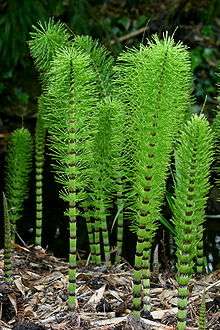Equisetidae
| Equisetidae | |
|---|---|
 | |
| Equisetum telmateia | |
| Scientific classification | |
| Kingdom: | Plantae |
| Subkingdom: | Embryophyta |
| (unranked): | Tracheophyta |
| (unranked): | euphyllophytes |
| Class: | Polypodiopsida |
| Subclass: | Equisetidae C. Agardh |
| Type genus | |
| Equisetum L. | |
| Orders | |
| |
| Synonyms | |
| |
Equisetidae is a subclass of Polypodiopsida (ferns). This subclass comprises the group commonly known as horsetails. It is equivalent to the class Equisetopsida sensu stricto in previous classifications.
Taxonomy
The horsetails or Equisetum had long been considered separate from the Polypodiopsida (ferns), until Pryer et al. (2001)[1] demonstrated that they belonged to the fern lineage.[2] The division of the ferns into four major groups has been demonstrated using both molecular[3] and morphological criteria.[4] Smith et al. (2006) carried out the first higher-level pteridophyte classification published in the molecular phylogenetic era, and considered the ferns (monilophytes), with four classes, and the horsetails as class Equisetopsida sensu stricto.[3] This distinction is necessary because of the alternative usage of Equisetopsida sensu lato as a synonym for all land plants (Embryophyta) with rank of class.[5] Chase and Reveal (2009) treated the horsetails as subclass Equisetidae of class Equisetopsida sensu lato. Subsequent classifications have treated this group similarly, except that the Pteridophyte Phylogeny Group place Equisetidae as a subclass of class Polypodiopsida (ferns).[6]
Equisetidae is a monotypic subclass consisting of a single order, Equisetales, single family Equisetaceae and single genus, Equisetum. The following diagram shows a likely phylogenic relationship between subclass Equisetidae and the other fern subclasses according to the Pteridophyte Phylogeny Group. The first three small subclasses are sometimes informally referred to as eusporangiate ferns, in contrast to the largest subclass, Polypodiidae or leptosporangiate ferns.[6]
| Polypodiopsida |
| ||||||||||||||||||
References
Bibliography
| Wikimedia Commons has media related to Equisetales. |
| Wikispecies has information related to Equisetales |
- Chase, Mark W.; Reveal, James L. (2009). "A phylogenetic classification of the land plants to accompany APG III". Botanical Journal of the Linnean Society. 161: 122–127. doi:10.1111/j.1095-8339.2009.01002.x.
- Christenhusz, M. J. M.; Zhang, X. C.; Schneider, H. (18 February 2011). "A linear sequence of extant families and genera of lycophytes and ferns". Phytotaxa. 19 (1): 7. doi:10.11646/phytotaxa.19.1.2.
- Christenhusz, Maarten J.M.; Chase, Mark W. (2014). "Trends and concepts in fern classification". Annals of Botany. 113 (4): 571–594. doi:10.1093/aob/mct299. PMC 3936591. PMID 24532607.
- Pryer, Kathleen M.; Schneider, Harald; Smith, Alan R.; Cranfill, Raymond; Wolf, Paul G.; Hunt, Jeffrey S.; Sipes, Sedonia D. (2001). "Horsetails and ferns are a monophyletic group and the closest living relatives to seed plants". Nature. 409 (6820): 618–622. doi:10.1038/35054555. PMID 11214320.
- Pteridophyte Phylogeny Group (November 2016). "A community-derived classification for extant lycophytes and ferns". Journal of Systematics and Evolution. 54 (6): 563–603. doi:10.1111/jse.12229.
- Schneider, Harald; Smith, Alan R.; Pryer, Kathleen M. (1 July 2009). "Is Morphology Really at Odds with Molecules in Estimating Fern Phylogeny?". Systematic Botany. 34 (3): 455–475. doi:10.1600/036364409789271209.
- Smith, Alan R.; Kathleen M. Pryer; Eric Schuettpelz; Petra Korall; Harald Schneider; Paul G. Wolf (2006). "A classification for extant ferns" (PDF). Taxon. 55 (3): 705–731. doi:10.2307/25065646. JSTOR 25065646.